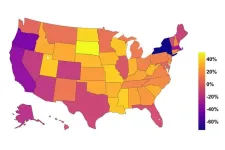(Press-News.org) NEW YORK, NY (October 5, 2023) – Researchers have used CRISPR gene editing, stem cells and human neurons to study the impact of a gene that is commonly mutated in autism. This new study, published today in The American Journal of Human Genetics, ties mutations in the gene CHD8 with a broad spectrum of molecular and cellular defects in human cortical neurons.
Autism is a highly heritable disorder with a recent increase in incidence — approximately 1 in 40 children in the US are diagnosed with autism. Over the past decade, sequencing studies have found many genes associated with autism but it has been challenging to understand how mutations in certain genes drive complex changes in brain activity and function.
The study was led by researchers in Dr. Neville Sanjana’s lab at the New York Genome Center and New York University (NYU) and in Dr. Jen Pan’s lab at the Broad Institute and includes co-authors from the Massachusetts Institute of Technology (MIT), Cold Spring Harbor Laboratory, ETH Zurich and McGill University. The team developed an integrated approach to understand how mutations in the CHD8 gene alter genome regulation, gene expression, neuron function, and are tied to other key genes that play a role in autism.
For more than a decade, it has been known that individuals with mutations in the CHD8 gene tend to have many similar ailments, such as autism, an abnormally large head size, digestive issues and difficulty sleeping. The CHD8 gene is a regulator of proteins called chromatin that surround the DNA but it is unclear how this particular gene might relate to major alterations in neural development and, in turn, result in autism.
The research team identified numerous changes in physical state of DNA, which makes the genome more accessible to regulators of gene expression, and, in turn, drives aberrant expression of hundreds of genes. These molecular defects resulted in clear functional changes in neurons that carry the CHD8 mutation. These neurons are much less talkative: They are activated less often and send fewer messages across their synapses.
The study authors initially observed these changes using human cortical neurons differentiated from stem cells where CRISPR was used to insert a CHD8 mutation. These findings were further bolstered by similar reductions in neuron and synpase activity when examining neurons from mice with a CHD8 mutation. These substantial defects in neuron function were circumvented when extra CHD8 was added to the cell using a gene therapy approach. In this case, extra copies of a healthy CHD8 gene without any mutation were added using a viral vector. Upon differentiation, the team found that the neurons rescued by the treatment returned to a normal rate of activity and synaptic communication, indicating that this gene therapy approach may be sufficient to restore function.
Lastly, when examining disrupted genes, the authors found that the CHD8 mutation seemed to specifically alter other genes that have been implicated in autism or intellectual disability, but not genes associated with unrelated disorders like cardiovascular disease. This suggest that CHD8 might influence selectively those genes that tend to be involved in neurodevelopmental disorders, providing an explanation for some of the particular characteristics of individuals carrying a CHD8 mutation.
Additional study authors include Congyi Lu and Alba Corman of the New York Genome Center and NYU; Xi Shi, Alexandra Nikish, and Feng Zhang of MIT and the Broad Institute; Ivan Iossifov of the New York Genome Center and Cold Spring Harbor; Yang Zhou of McGill University and Montreal Neurological Institute; Randy J. Platt of ETH Zurich. The research was funded by the Simons Foundation for Autism Research (SFARI), the Simons Center for the Social Brain at MIT, the Brain & Behavior Foundation and the National Institutes of Health.
##
About the New York Genome Center: The New York Genome Center (NYGC) is an independent, nonprofit academic research institution that serves as a multi-institutional hub for collaborative genomic research. Leveraging our strengths in technology development, computational biology, and whole genome sequencing, our mission is to advance genomic science and its application to novel biomedical discoveries. NYGC’s areas of focus include the development of computational and experimental genomic methods and disease-focused research to advance the understanding of the genetic basis of cancer, neurodegenerative disease, and neuropsychiatric disease. We are committed to prioritizing diversity, equity, and inclusion, which is fundamental to promoting greater collaboration, innovation, and discovery. https://www.nygenome.org/
END
Precise gene editing in human stem cells and neurons reveals links between genome organization and autism
CRISPR editing allows for in-depth study of leading candidate gene for autism spectrum disorder
2023-10-05
ELSE PRESS RELEASES FROM THIS DATE:
AI helps reduce online harassment by enhancing conversation courtesy
2023-10-05
Check the comments section of many social media and digital news platforms, and you’re likely to find a cesspool of insults, threats and even harassment. In fact, a Pew Research Center survey found that 41% of American adults have personally experienced online harassment, and one in five adults say they’ve been harassed online for their political views.
But researchers at BYU and Duke University say derisive online conversations don’t have to be the norm. A joint paper between the two universities found that artificial intelligence can be used to improve conversation quality and promote civil dialogue in online ...
Two-day course teaches hospitals and health systems how to address unprofessionalism and unsafe behavior
2023-10-05
With a myriad of external pressures and challenges facing hospitals and health systems today, it is more important now than ever to mitigate internal risks. Unprofessional behavior, which negatively impacts patient care, retention, and team dynamics, is a legal, financial, and cultural risk that many health systems are now looking to address head-on. Peer-reviewed research consistently shows unprofessional behavior in health systems can be reduced by 85% through implementing the right tools and processes.
The Vanderbilt ...
Study highlights use of TikTok to encourage cervical cancer screening
2023-10-05
TikTok and other short-form video platforms are booming in popularity — for entertainment and for sharing information, including health information.
Researchers are currently examining the effects of social media videos, and among them is Ciera Kirkpatrick, assistant professor of advertising and public relations at the University of Nebraska–Lincoln. Kirkpatrick, who studies the intersection of communication and health, recently turned her scientific eye toward TikTok.
In a newly published article, Kirkpatrick and co-author LaRissa Lawrie, a doctoral ...
K-pop fans helped COVID-19 public health messaging go viral
2023-10-05
Three years ago, as part of the public health messaging in response to the COVID-19 pandemic, the World Health Organization launched the "Wear A Mask" campaign on social media.
However, despite their benefits to public health, mask-wearing quickly became a highly politicized and divisive issue across the globe.
But the campaign gained impressive traction after World Health Organization Director-General Tedros Adhanom Ghebreyesus issued the following tweet on X, the social media platform known at the time as Twitter, on August 21, 2020, thanking BTS, a South Korean K-pop group, for supporting the mask-wearing public ...
Physicists find evidence for magnetically bound excitons
2023-10-05
In art, the negative space in a painting can be just as important as the painting itself. Something similar is true in insulating materials, where the empty spaces left behind by missing electrons play a crucial role in determining the material's properties. When a negatively charged electron is excited by light, it leaves behind a positive hole. Because the hole and the electron are oppositely charged, they are attracted to each other and form a bond. The resulting pair, which is short lived, is known as an exciton [pronounced exit-tawn].
Excitons are a key part of many technologies, including solar panels, photodetectors and sensors, as well as light-emitting ...
Dr. Julie Damp named ACC Annual Scientific Session Vice Chair
2023-10-05
The American College of Cardiology has announced Julie Damp, MD, FACC, as the next vice chair of the American College of Cardiology’s Annual Scientific Session. Damp will serve as vice chair for ACC.25 and ACC.26 and transition to chair for ACC.27 and ACC.28.
"ACC Annual Scientific Session is an incredibly impactful learning experience for cardiovascular care providers globally,” Damp said. “I am truly honored and excited to have the opportunity to work with the ACC team to provide effective and innovative education that impacts the care of our patients and expands the reach of cardiovascular science."
Damp is a professor of medicine in cardiovascular medicine ...
New research may make future design of nanotechnology safer with fewer side effects
2023-10-05
A new study may offer a strategy that mitigates negative side effects associated with intravenous injection of nanoparticles commonly used in medicine.
The study was published today in Nature Nanotechnology.
“Nanotechnology’s main advantage over conventional medical treatments is its ability to more precisely target tissues, such as cancer cells targeted by chemotherapy. However, when nanoparticles are injected, they can activate part of the immune system called complement,” said senior author Dmitri Simberg, Ph.D., professor of Nanomedicine and Nanosafety at the University of Colorado Skaggs School of Pharmacy ...
Climate intervention technologies may create winners and losers in world food supply
2023-10-05
A technology being studied to curb climate change – one that could be put in place in one or two decades if work on the technology began now – would affect food productivity in parts of planet Earth in dramatically different ways, benefiting some areas, and adversely affecting others, according to projections prepared by a Rutgers-led team of scientists.
Writing in the journal, Nature Food, the scientists described the results of computer models simulating varying climate scenarios and their impacts over time on the production of the world’s four major food crops: ...
Racial and ethnic disparities in glycemic control among insured adults
2023-10-05
About The Study: In this study of 4,070 insured adults with diabetes, disparities in poor glycemic control persisted despite adjustment for social, health care, and behavioral factors. Research is needed to identify the barriers contributing to poor control even in populations with access to care.
Authors: Sandra S. Albrecht, Ph.D., M.P.H., of the Columbia University Mailman School of Public Health in New York, is the corresponding author.
To access the embargoed study: Visit our For The Media website at this link https://media.jamanetwork.com/
(doi:10.1001/jamanetworkopen.2023.36307)
Editor’s Note: Please see the article ...
Changes in cannabis-attributable hospitalizations following nonmedical cannabis legalization in Canada
2023-10-05
About The Study: This study of 26.9 million individuals in four Canadian provinces found that cannabis legalization with restrictions was not associated with an increase in hospitalizations due to cannabis but commercialization was. The findings suggest that commercialization of cannabis may be associated with increases in cannabis-related health harms, including cannabis-induced psychosis.
Authors: Daniel T. Myran, M.D., M.P.H., of the Ottawa Hospital Research Institute in Ottawa, Ontario, Canada, is the corresponding author.
To ...
LAST 30 PRESS RELEASES:
Tracing the quick synthesis of an industrially important catalyst
New software sheds light on cancer’s hidden genetic networks
UT Health San Antonio awarded $3 million in CPRIT grants to bolster cancer research and prevention efforts in South Texas
Third symposium spotlights global challenge of new contaminants in China’s fight against pollution
From straw to soil harmony: International team reveals how biochar supercharges carbon-smart farming
Myeloma: How AI is redrawing the map of cancer care
Manhattan E. Charurat, Ph.D., MHS invested as the Homer and Martha Gudelsky Distinguished Professor in Medicine at the University of Maryland School of Medicine
Insilico Medicine’s Pharma.AI Q4 Winter Launch Recap: Revolutionizing drug discovery with cutting-edge AI innovations, accelerating the path to pharmaceutical superintelligence
Nanoplastics have diet-dependent impacts on digestive system health
Brain neuron death occurs throughout life and increases with age, a natural human protein drug may halt neuron death in Alzheimer’s disease
SPIE and CLP announce the recipients of the 2025 Advanced Photonics Young Innovator Award
Lessons from the Caldor Fire’s Christmas Valley ‘Miracle’
Ant societies rose by trading individual protection for collective power
Research reveals how ancient viral DNA shapes early embryonic development
A molecular gatekeeper that controls protein synthesis
New ‘cloaking device’ concept to shield sensitive tech from magnetic fields
Researchers show impact of mountain building and climate change on alpine biodiversity
Study models the transition from Neanderthals to modern humans in Europe
University of Phoenix College of Doctoral Studies releases white paper on AI-driven skilling to reduce burnout and restore worker autonomy
AIs fail at the game of visual “telephone”
The levers for a sustainable food system
Potential changes in US homelessness by ending federal support for housing first programs
Vulnerability of large language models to prompt injection when providing medical advice
Researchers develop new system for high-energy-density, long-life, multi-electron transfer bromine-based flow batteries
Ending federal support for housing first programs could increase U.S. homelessness by 5% in one year, new JAMA study finds
New research uncovers molecular ‘safety switch’ shielding cancers from immune attack
Bacteria resisting viral infection can still sink carbon to ocean floor
Younger biological age may increase depression risk in older women during COVID-19
Bharat Innovates 2026 National Basecamp Showcases India’s Most Promising Deep-Tech Ventures
Here’s what determines whether your income level rises or falls
[Press-News.org] Precise gene editing in human stem cells and neurons reveals links between genome organization and autismCRISPR editing allows for in-depth study of leading candidate gene for autism spectrum disorder



